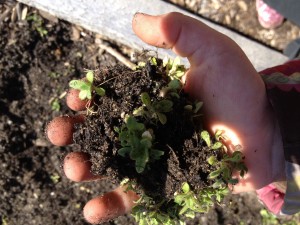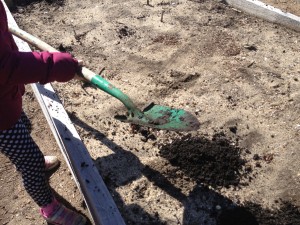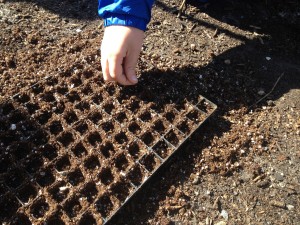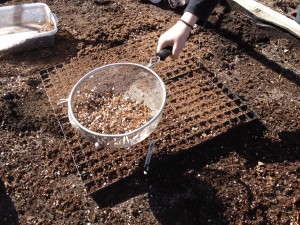With a cheshire cat smile, a third grade girl held up both hands and said, “I have dirty hands!” Her friend chimed in, “That’s part of gardening-getting dirty!”
Temperatures may still hover in the uncomfortable 40 degree (F) range with a biting cold wind, but the garden cries out for food and care, so the children bundled up and got to work in the dirt. While the seeds planted in flats the previous week work quietly under the soil, waiting to germinate, the garden beds need to be prepped.
The 5th graders, full of preadolescent energy, took the lead role in hauling recently delivered compost to the beds. This required shovels, digging and pushing wheelbarrows. This is “Heavy Work,” which activates the nerves (proprioceptors) that facilitate filters and organization in the brain. The kids engaged in boisterous fun while they worked and when they returned to class they settled down quickly with renewed ability to concentrate!
The 4th grade students lined up on both sides of the raised bed and took turns scooping compost and delivering it to a designated place in the bed. It looked like a relay race.
 Kindergarten and third graders weeded the raised beds, making sure to get the roots. For the K’s it was a great exercise in strengthening their pincer grasp. For the third graders, they employed visual perceptual skills, scanning the beds to seek out the weeds missed by their predecessors.
Kindergarten and third graders weeded the raised beds, making sure to get the roots. For the K’s it was a great exercise in strengthening their pincer grasp. For the third graders, they employed visual perceptual skills, scanning the beds to seek out the weeds missed by their predecessors.
All groups learned:
- Not to stand on the soil because it gets too compact and makes it hard for baby seedlings to grow
- Mulch helps to keep soil moist and blocks weed growth (Our garden uses eel grass gathered at a nearby beach)
- Earthworms are a sign of healthy soil and a best friend to the garden
Each group got to plant as well. To feed a school takes a lot of seeds!
They planted:
- Herbs (Parsley and Basil)
- Lettuce and spinach in large free standing pots
- Pea seedlings for micro-greens
Equipment:
- Planting soil and Compost
- Shovels
- Wheelbarrow, wagon or large bins dragged/pushed or on a cart
- Sieve (or onion bag to shake out planting soil)
- Flats and plugs
Directions:
- After soil prepped, use yogurt scoops* to fill plugs and trays
- Seeds broadcast in trays (peas) and individually placed in plugs (herbs)
- Seeds (greens) broadcast in large plastic pots
- Seeds covered finely with soil pressed through a sieve
*Determine size by how many scoops needed to make sure everyone has a turn. If you have a large group and only a few flats to fill, use smaller sized scoops.
Benefits:
- Heavy work of lifting and shoveling activates proprioceptors that help with attention and brain organization.
- Shoveling and hauling are cardio workouts…and muscle strengtheners!
- Shoveling requires two hands-building bilateral motor coordination.
- Weeding strengthens muscles in the hands and fingers.
- Working the soil is a fabulous tactile activity.
- Students learn about the importance of healthy soil and how to create this nutrient rich soil.
- Students learn proper techniques in prepping beds for planting.
- Students learn proper techniques in planting flats and plugs for seedlings.
This post reflects the partnership and creative collaboration between The Motor Story and Sustainable CAPE.



